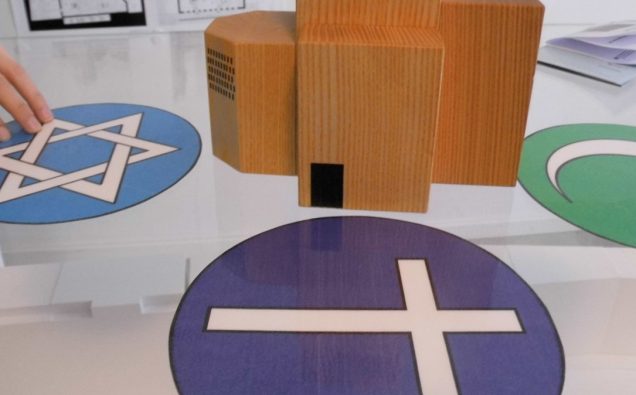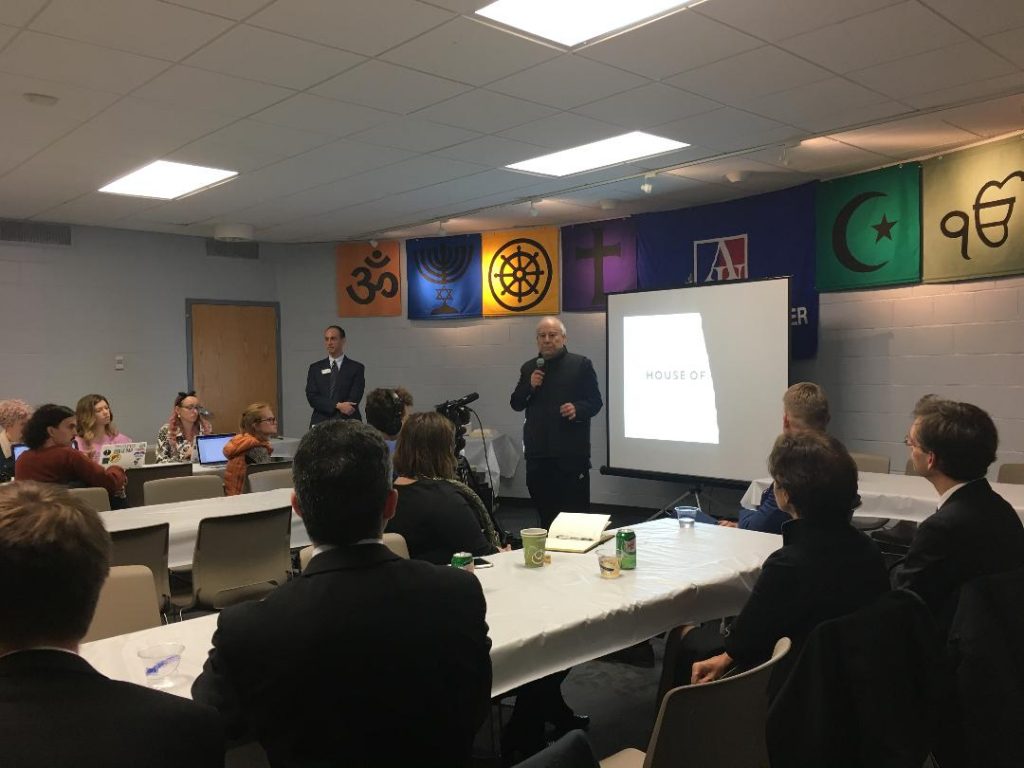
Photo: House of One Berlin/Facebook Page
In the same country where six million Jews were killed in the Holocaust, the genocide to define all genocides, and where the Far Right is once again emerging from the margins, with some political figures calling mainly Muslim refugees “cattle,” “filth,” and “scum” and discussing how they are causing a “creeping genocide against the German population,” I have found one of the world’s most inspiring religious bridge-building endeavors taking shape.
It is called The House of One in Berlin, and it is a joint initiative by Christian, Jewish, and Muslim leaders to build a shared worship space in the heart of the city, a stone’s throw from where the Berlin Wall once stood dividing a nation in two. Located on the foundation of Berlin’s first church, built in the 12th century before being attacked during World War II and later demolished under the East German government in 1964, the building will consist of three separate worship spaces joined together by a communal hall, through which members of each community will walk and interact with one another as they enter and exit their respective spaces. Architect Wilfried Kuehn, in reflecting on the design proposal for the House of One, described the building as “a sequence of spaces that distinctly inhabit the building and yet also reflect the city. They’re like the stations on a pilgrim’s journey.”
On November 16, 2017, representatives of the House of One came to American University during their visit to Washington to present the impetus behind their project in our campus’s very own multi-faith sacred space, the Kay Spiritual Life Center. The visit was coordinated by the distinguished scholar-diplomat Dr. Stefan Buchwald of the German Embassy, Speaking during a lunchtime function hosted by AU’s chaplain, Rev. Mark Schaefer, the delegations shared with students, faculty, community members, and State Department representatives their expansive vision for a marquis multi-faith house of worship in the heart of one of the West’s great capitals. Given my commitment to building bridges I was intrigued by the idea.
Invited to deliver opening remarks for the lunchtime program to welcome the delegation, I harkened back to the great legacy of bridge building in Andalusia and discussed the powerful legacy of the 13th-century Holy Roman Emperor, Frederick II, and how he exemplifies the heights which can be achieved when a leader reaches out across faith lines. Frederick, of noble German ancestry, had a Muslim bodyguard, featured Arabic script on his royal mantle, and frequently corresponded with the leading Muslim scientists and intellectuals of the era. I also recalled how Frederick so impressed the Sultan of Egypt that at the height of the Crusades, Frederick was given control of the city of Jerusalem without the spilling of a single drop of blood. Following the transfer, Frederick, rather than seeking vengeance over the city’s Muslim population, ensured Muslims worshipped and lived as they wished.
The House of One was represented by Roland Stolte of the Board of Directors, Pastor Eric Haussmann of St. Marien’s Church, Imam Osman Oers of the Muslim Initiative for Dialogue Forum, and Barbara Witting of the Jewish community and Board of Directors.

Ambassador Akbar Ahmed delivers opening remarks to the House of One delegation upon their visit to American University from Berlin on Nov. 16, emphasizing the importance of strengthening interfaith initiatives in the US, Europe, and around the globe.
Pastor Haussmann presented on behalf of the delegation, opening his remarks with a discussion on the importance of meaningful encounters across faith lines in fostering bridge-building. He noted that supporting and encouraging such exchanges, which can occur through such activities as sharing a meal together, is the primary goal of the House of One and is the reason why the space is designed with such a prominent central communal hall. Haussmann also explained how equal collaboration among the faith communities has been key in conceiving the project, as for an effective bridge-building initiative to be implemented, no one party can dominate outright.
Haussmann told us as well how the great American hero, Dr. Martin Luther King Jr., helped inspire their project. Dr. King’s Nobel Peace Prize acceptance speech in Oslo also served as a key inspiration for the mission of the House of One: “We have inherited a large house, a great ‘world house’ in which we have to live together – black and white, Easterner and Westerner, Gentile and Jew, Catholic and Protestant, Muslim and Hindu – a family unduly separated in ideas, culture and interest, who, because we can never again live apart, must learn somehow to live with each other in peace.” This is a message which the House of One has taken to heart and is bringing to life in today’s fraught world.
At the end of Haussmann’s presentation, I advised the delegation that they should consider expanding beyond the Abrahamic faiths in carrying out their vision. In many regions of the globe, like our own in South Asia, many faith communities like Hinduism and Buddhism are non-Abrahamic. As such, I explained the initiative would run the risk of being seen as exclusionary without including these diverse faiths, which is fundamentally contrary to the bridge-building work they are pursuing. They appreciated the point.
As we enter 2018 with the background din of great divisions, turmoil, and exclusion in Europe, the US, and throughout the world, I find it heartening to hear from faith leaders who are dedicating their time and resources to programs which bring people together. May the House of One receive the support it so desperately needs so it can serve as a leading symbol of unity in a land once known primarily for the horrors of the Holocaust.
















